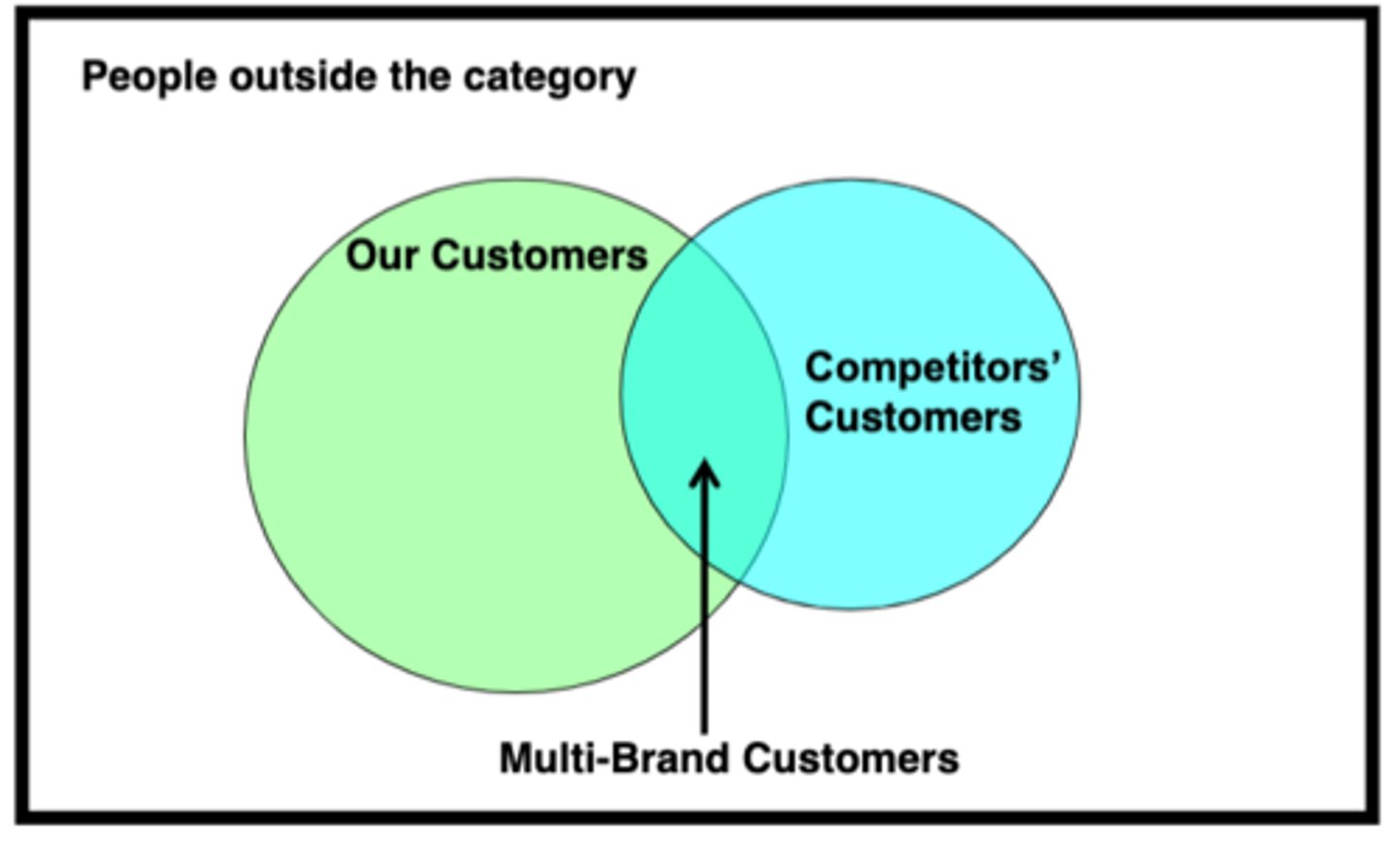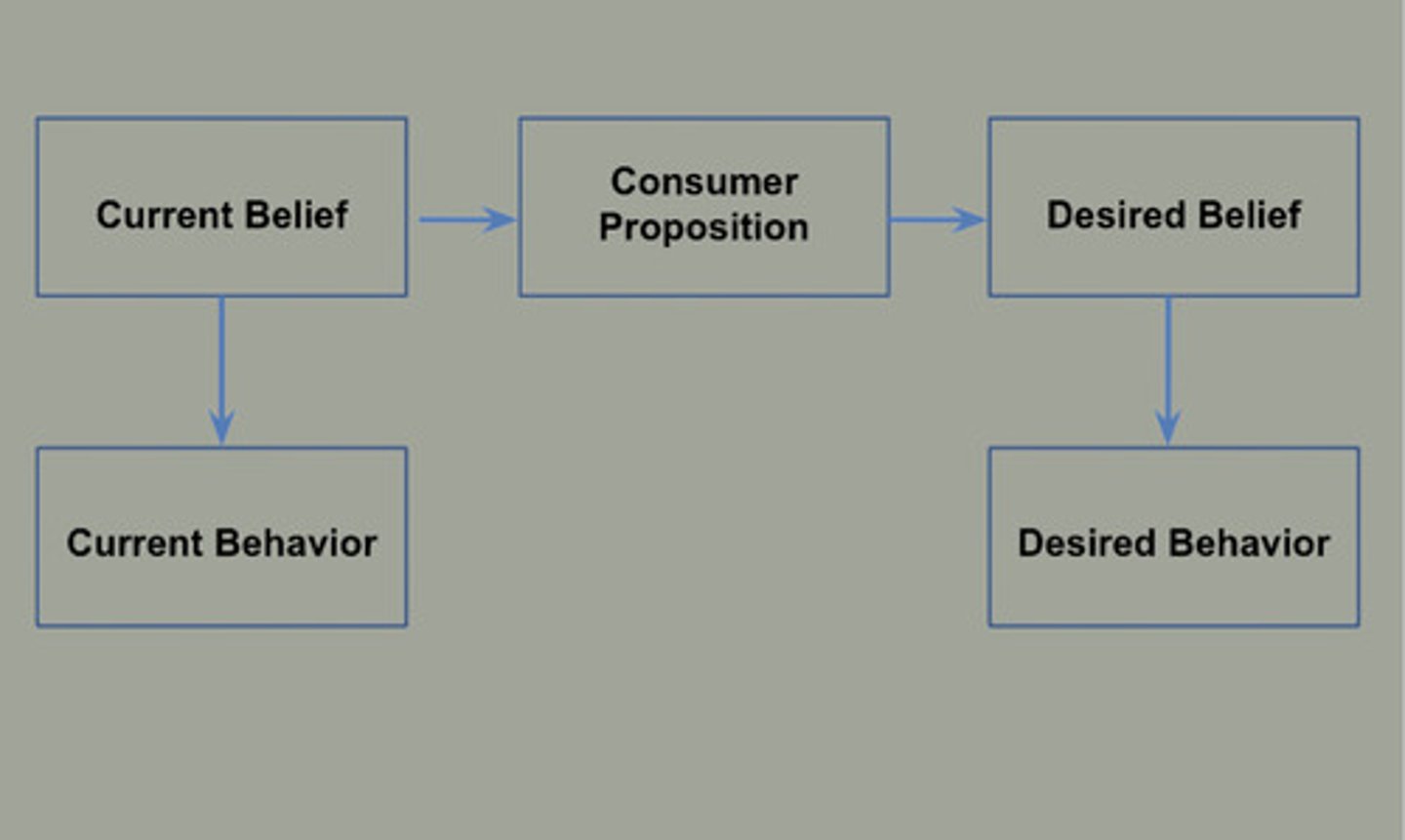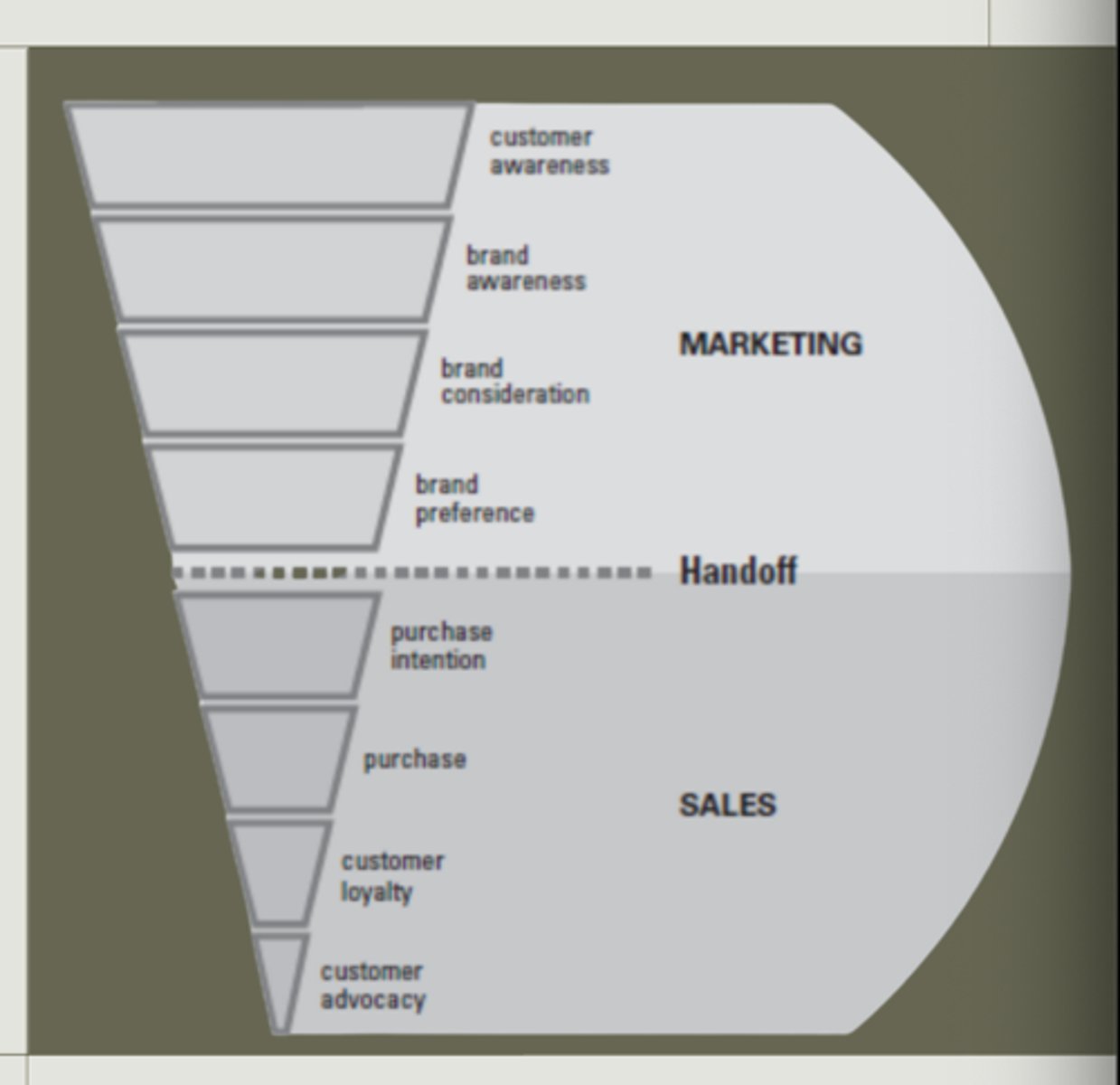MKT 300 [University of Michigan - Ross]
1/137
There's no tags or description
Looks like no tags are added yet.
Name | Mastery | Learn | Test | Matching | Spaced |
|---|
No study sessions yet.
138 Terms
Marketing Myopia
Myopia = nearsighted
When companies are too PRODUCT ORIENTATED instead of CONSUMER ORIENTED
What business are we really in?
Quarter inch drill = quarter inch hole`
Three Long-Held Concepts Every Marketer Should Rethink
1. Brand
- b4 ppl relied on brands to ensure quality, now there are others ways to do this (internet)
= less barries for entry into the market and MORE brand volatity
2. LOYALTY
- ppl used to be very brand loayal, now ppl have more access to info
= LESS brand loyalty
3. POSITTIONING
- consumers evaluate multiple attributes = you can no longer define your brand by one feature
Fundamental Entity (FE)
The perspective from which you will create marketing strategy
- relevant when there is a PARENT BRAND with sub brands
core competence
Firm skills that competitors cannot easily match or imitate.
- leads to sustainable compettive advantage
- can be technical but often intangible components(implicit learning, organizational coordination, corporate culture)
- an iNPUT not an output
- generates strategic assets, which in turn generate benefits for consumers
umbrella brand
a family of products that all deliver the same higher-order benefit
ex: crest
distinct branding
firms offer several products with distinct meanings, brand names, and logos, targeted to different audiences
ex: consumer packaged goods
hybrid branding
A branding approach that combines two brands - the corporate brand plus separate brands - to designate differences in product or service lines.
ex: BMW (keeps mini cooper seperate from other cars to distinct it)
three types of brand extensions
1. product line extensions
2. category extentions
3 branded varients
- popular bc it can alleviate boredom
product line extentions
ex: doritos: cool ranch, late night, spicy
same catagory - different products (ex: flavors)
Product Extentions
items offered in addition to the product to make it more attractive to the target market
EX: law and order
= law and order special vitimes unit
law and order criminal intent
law and order trial by jury
category extensions
When a firm uses its brand to expand into new product categories
- much risker
ex: Swiss (watch, knife, perfume)
every catagory extension is a brand extension
billboard effect
Bran extensions, same color/scheme make an assortment look like a billboard
makes you think of the central brand
Why do we see so many brand extensions?
pricing breadth, lower cost, capitalize on placebo effects, risk minimization
- consumers can alleviate boredom, but stay in family
brand dillution
occurs when a brand extension adversely affects consumer perceptions about the attributes the core brand is believed to hold
Levitt's argument
selling focuses on sellers needs
marketing focuses on consumers needs
*selling not equal to marketing
super consumers
1. combine big spending with high engagement and deep interest in new uses for a new product (not just heavy users)
- they exist in most businesses
- they WILL buy more - they account for 3x as much growth as other consumers
80/20 Rule (Pareto Principle)
- 80% of a companies profits are derived from 20% of it's consumers
Customer Relationship Management (CRM)
a company-wide business strategy designed to optimize profitability, revenue, and customer satisfaction by focusing on highly defined and precise customer groups
product BUILT off the customer
proactive vs reactive campaigns
reactive: a customer is going to leave and then you are REACTING to that news
proactive: preventing a customer from leaving
- can result in false negatives (failng to identify customers who intend to leave)
- false positives: offering incentives to stay to customers who never had any intention of leaving (=wasted materials + may convince them they aren't suing serve enough)
RFM
RECENCEY
- how recent their pruchase was
FREQUENCY
- how often they buy it
MONETARY
- how much do they spend
attitude
what consumers think and feel about your brand
contractual setting
we observe the time at which customers become inactive (churn)
ex: memberships
churn
the number of consumers who stop using a product or service, divided by the average number of consumers of that product or service
- EXIT
noncontractual
we do NOT observe the time at which customers become inactive
ex: people buying a brand of peanut butter
loyalty
a deeply held commitment to rebuy a product or service despite situational influences and marketing effors having the potential to cause deection
benefits of loyalty
can be a barrier to entry
intertia: allows time to respond to competitor innovation + protection against price attacks
source of price premiums
price premiums
additional amount a customer will pay for the brand in comparison with another brand offering similar benefits
see how much of a price increase a consmer will deal with before moving along and then the difference is the price premium
butterflies
hi profitable, short term customers
true friends
high profitability, long-term loyalty
strangers
lo profitability, short term customers
barnacels + what we want to target
low profitability, long term customers
look for size of wallet and share of wallet - we want to go after those with a share of wallet problem
customer lifetime value (CLV)
present value of all future profits generated from a particular customer
function of : margins, annual retention rate, discount rate
margins (m)
annual revenue-operating expenses
positive relationship with CLV
m=AR-OE
annual retention rate: (r)
percent of current customers who will still be with the firm at the end of the year
positive relationship with CLV
discount rate (d)
cost of capital that you use to discount future cashflows
typically around 10-16%
negative relationship with clv
customer lifetime value formula
$ margin x (retention rate % / 1 + discount rate % - retention rate %)
sets an upper bound when we are deciding how much to spend on a retention campaign
r is constant
heterogeneity
the variability of the inputs and outputs of services, which causes services to tend to be less standardized and uniform than goods
survivor bias
aggregate retention rate increases over time, even though the underlying retention rate for each customer has not changed
ex: views for season drop a lot after episode 1, barely drop after episode 2 - the retention rate shouldnt be different its just survivor bias
acquire new customers or retain existing customers?
try and retain customers you already have - those customers will then go on to spread positive word of mouth
Acquisition marketing objective
ex: advertising to build awareness. headon headache medicine: straightforward, almost annoying, but gets people's attention.
ex: leveraging awareness of stronger competitor: 7up "theres no cola like the Uncola"
Leveraging awareness of stronger competitor
retention marketing objective
ex: ads that focus less on the product: wassup budweiser commericial.
ex: kroger card, mcdonalds monopoly board, loyaly cardsd,
who do reward programs affect most
light buyers have the biggest increase, heavy uyers are already using a lot
loyalty programs
need to have good incentives but not TOO good
most grocery store membership cards reward card ownership, not loyalty
some companies starting to reward proitability over mere volume of purchases
creates barriers to exit (ex: airline miles that disappear if you leave)
- encourage purchases that woudlnt normally happen
loyalty progams CANNOT:
- build emotional attachment
- benefits frequent pruchases the most (is this who we want to offer discounts to?)
goal gradient hypothesis
goal pursuit intensifies the closer we get to a goal with a clearly defined end state
ex: make the bubbles on a punch card bigger at the beginning/give more points at the beginning
ex: charity donations - ppl more likely to donate when you are close to your goal
SOV
SOURCE OF VOLUME
1. SD: Stimulate Demand
2. SS: Steal Share
MO
Marketing Objective
Acq: Acquition
Ret: Retention
category
the brand with which a brand competes and which function as close substitutes
if consumers to do commonly choose between two brands, they should probs not be considered in the same category
POP
Point of Partity
attributes or benefits that ALL brands within a category offer
necessary but not sufficient enough for success
liscence to compete in the category
POD
Point of Difference
attiributes or benefits that consumers strongly associate with a brand, positively value, and believe they could not find to the same extent with a competitor
ex: in fast food service, subways POD is healthiness
good brands can have lots of pods
four types of customers
loyalists
competitor loyalits
cheaters (multibrand consumers)
people outside of the category

stimulating demand
stimulate heightened usage among current customers
when the total market expands who benefits
the category leader usually gains the most = perk of being category leader
category leader will generally be motivated to expand the category - other competitors might not want to promote as it will just give the leader more recogniitioin
prototypical
one brands name is synonymous with the category name
ex: tissue = kleenex
bandage = bandaid
price promotions
Promotions when products are offered at a discounted price
if usuage is inflexible and prodcut is non-perishable, price promotions can encourage consumers to stockpile
perishable goods are always flexible
flexible vs inflexible usage
flexible = if you have more you consume more (chocolate)
inflexible: toliet paper: you typically only consume a set amount
steal share
targeting competitors costomers
usually the strategy of choice for non category leders
ads that invoke comparision with the cateogry leader
cant create ambiguity about category membership (can create a need to reassure that the brand has the required POP)
frontal attack
-Head-on attack of fundamental aspects of leader (e.g.,
Pepsi tastes better than Coke)
- Challengers need high resources
flank attack
attack a leaders weak points, blind spots (internal)
ex: attack an area where leader is geographically weak
attack a segment that has been neglected by leader
try not to pick on a small competitor
COKE VS PEPSI
hypercompetition
Coca cola = inventor of marketing
- synonymous with happiness, santa, american values, home
Pepsi: young generation, music, modern, fun
Pepsi makes FRONTAL attack against coke: attacking the taste and everyone prefers Pepsi = coke create a NEW coke - but people were mad as coke isnt all about the taste, its about the BRAND
Coke now less focused on fighting pepsi, more focused on saving the category
why was the pepsi taste challenge not entirely accurage
1. we typically have more than one sip
2. we normally KNOW what we're consuming
do you want to have 100% market share
NO
Competition can be good
at some point when you get to 100% market share your profits go down - you want to maximize profitability not market share
getting to 100% market share requires a lot of additiioal costs - eventually the cost of adding an additional customer will outweight the value they bring you
placebo effect
expectations drive experience
perceptual map
displays, in two or more dimensions, the position of products or brands in the consumer's mind
spiderwe type
STP
Segmentation, Targeting, Positioning
Red Oceans and blue oceans
red oceans: crowded-blood bath markets
blue oceans: unknown, unconested markets
RED OCEAN TRAPS
1. focusing too closely on what existing customers want and not WHY non-onsumers arent customers
2. niche existing space does NOT equal new market space
3. technology innovation does NOT equal market strategiy / new market
4. creative descrubtion does NOT equal market creation
5. differentiation is not always the key to success
Segmentation
the process of dividing a larger market into smaller pieces based on one or more meaningfully shared characteristics
only target markets that are likely to be responsive
ATTITUDE is the golden segmentation variable
- demographics can lead to you missing things
common segment defenition
a group of customers sharing at least one characteristic that should increase their responsiveness to a marketing effort
compromise between mass marketing and one to one marketing
mass marketing = least cost
one to one marketing = most cost
mass marketing
using a single marketing strategy to reach all customers
ex" customers can choose any color of model t as long as its black"
one to one marketing exampes
amazon recommendations, nike shoe customization
when should you segment
when incremental value from customizing outweights costs of developing seperate offerings for each segment
MECE
mutually exclusive and comprehensively exhaustive - segments should be sufficienty different form one another so that they do not overlap
idenfitifed segments should include ALL consumers in a given market
variables on which consumers are commonly segemented
demographic: region, pop density, climate, gender, age, income, occupation
- demographic data is cheap and abundant, lots of sources
behavioral
- ads ofor nicorette gum in smoking lounges, wedding dress ads on the knot
- BUT purhcases dont always reflet our typical attitudes
attitudinal
- we LOVE
- thoughts, feelings, beliefs, desires, aspirations
- we can translate these to NEEDs (ex: i am a very busy person = i have a high need for convienence)
ex: CAMBELL:
- passionate kitchen master, uninvolved quick fixer, familiar taste pleaser, diciplined health manager (have legit fridges in thei office
- toothpastes (fresh breath, white teeth, low price, romanc)
- airport perspnalities
- very difficult to collect
gray powers
older couples in downtain areas, white collar, professional
one of the niche segments
generational segmentation by PNC
target those young kids with a easy to use banking product with the hope to get them to trade up over time
pink tax
the higher price paid for women's consumer items compared to similar products marketed to men
drawbacks of segmenting on demographic variables
potentially limits growth
- marketers cant grow a demographic segment but might be able to stimulate needs
social desirability bias
A tendency to give socially approved answers to questions about oneself.
conjoint analysis
determines the importance of different attributes to different segments of consumers
relative importance of product attributes is better measured when attributes are considered JOINTLY
forces consumers to make realistic tradeoffs
tells you
centrality
the first brand that comes to mind when you think about the category
distinctive ness
the degree to which the brand stands out fro others - better predictor of price
targeting
which segment do we pursue? who is in the selected segments?
vulnerable segments
Groups of consumers, for either psychological or economic reasons, are considered vulnerable (think gullible) to ad messages.
· Young children teens, elderly, economically, socially, physically, or mentally disadvantages
· Research argues that marketing any product to children under the age of 12 is inherently deceptive as they don't have the cognitive capacity to fully understand the purpose of advertising. It is argued that young children believe what they see and don't understand that advertising is persuasive and designed to convince them to do things or want things that they might not otherwise.
5 box positioning statement
Current Behavior, Current Belief, Consumer Proposition, Desired Belief, Desired Behavior

positioning
developing a specific marketing mix to influence potential customers' overall perception of a brand, product line, or organization in general
category confusion
ex: 7 up was a medicine and now a soda
need to establish a POP
positioning statement
a statement that summarizes company or brand positioning using this form: to (target segment and need) our (brand) is (concept) that (point of difference)
FUD FACTOR
Fear, Uncertainty, Doubt
often used in political advertising
curse of knowledge
Mistake of assuming that others know what you know
confirmation bias
a tendency to search for information that confirms one's preconceptions
personal selling
face to face communication meant ot increase the probability of purchase
B2C context but can also be B2B context
B2B: ex: manufacturer sales reps negotiating for shelf space at walmart
interactions between marketing and sales
marketing seen as a fuction that CREATES demand and sales seen as a function that FULFILLS demand

differences b/n sales and marketing
sales is much more tangible and can be measured sooner
sales people want lower price so they can sell sooner - neither feel like they hear each other - marketing blames sales for not selling, sales blames marketing for too grand of ideas/not appealing enough
push marketing
Use sales force and trade promotion money to induce intermediaries to carry, promote, and sell the product to end users
Appropriate when there is low brand loyalty in category and brand choice is made in the store
ex: getting the product FRONT AND CENTER - displays in a store
pull marketing
- Manufacturer uses advertising and other marketing communications to motivate consumers to seek out the product
- Appropriate when there is high brand loyalty and high involvement in category, and when consumers choose brand before going to store
bringing customers IN - highly effective relies on loyalty
commercials
standard assumption
measuring intentions does not influence the respondent's likelihood of acting upon those intentions
the mere measurement effect
On average, people who are asked to state intentions to perform socially acceptable/desirable behaviors are subsequently more likely to engage in those behaviors than people who are not asked to state intentions
ex: saying something outloud translates to that behavior
BUT the person must be able to imagine the situation - it is realistic
descriptive research methods
Scientific procedures that involve systematically observing behavior in order to describe the relationship among behaviors and events.
observation, sruveys, projective techniques, brain imaging
causal research methods
experiments, statistical/econometric methods
double barreled questions
questions that attempt to get at multiple issues at once, and so tend to receive incomplete or confusing answers
AVOID
ex: are you satisfied with the cost and quality of this product?